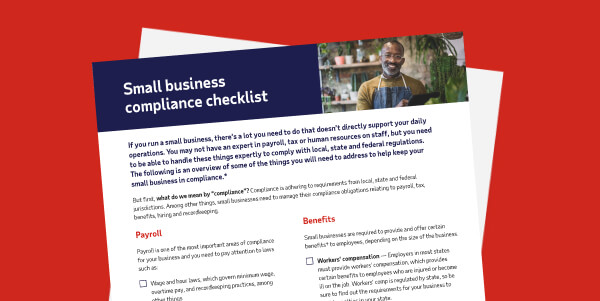Want more exclusive business insights like this delivered to your inbox?Subscribe now
Employee compensation is one of a company’s biggest expenses, which is why when faced with economic hardship, employers must sometimes make the difficult choice to either furlough or lay off workers. Both options reduce costs, but the similarities largely end there. Knowing the key differences between furloughs and layoffs, as well as the pros and cons of each, can be helpful when evaluating what’s best for the employees and the future of the business.

What is a furlough and how does it work?
A furlough is an unpaid leave of absence or reduction in hours typically resulting from a lack of work or budget cuts. Such situations are usually only temporary. For example, an employee that works 40 hours per week may be told to only work 30 hours per week for three months, while another may be instructed to not report to work at all for two months. When the furlough period ends, the employees resume their position and normal schedule.
Furlough for salaried or exempt employees
Under the rules of the Fair Labor Standards Act (FLSA), exempt employees must be paid their full salary for any week in which they perform work, regardless of the actual hours. This means that they can only be furloughed in weekly increments at minimum, during which time they are forbidden from engaging in any of their usual job responsibilities. Their access to work-related programs may even be restricted or their employer-issued devices confiscated to ensure compliance.
Furlough for hourly or non-exempt employees
Unlike salaried employees, hourly workers who are furloughed may continue to work in some circumstances. Their employer may simply reduce their total hours per day or their total days per week. Businesses also have the option of furloughing non-exempt employees for weeks or months at a time – a situation commonly referred to as zero hour schedules.
How long can a company furlough an employee?
The terms of a furlough are generally up to the employer’s discretion, but their length usually coincides with that of the downturn. It’s customary for businesses to notify employees in advance if there will be an extension. In some cases, however, protracted furloughs lead to layoffs.
How does a layoff work?
Layoffs are terminations due to no fault of the employee, i.e. not based on performance. They are usually permanent, although some businesses with seasonal consumer demand may rehire employees who were previously laid off when their busy season resumes.
What's the difference between a furlough and a layoff?
Furloughed individuals are still considered employees and usually resume their jobs at a later point, while those who are laid off are separated from their employer indefinitely. Further distinctions between furloughs and layoffs are as follows:
Healthcare benefits
A layoff is a qualifying event under the Consolidated Omnibus Budget Reconciliation Act (COBRA), but a furlough is not. Workers who are furloughed generally continue to receive health benefits through their employer, except for when their hours are reduced so much that they no longer meet the provider’s eligibility requirements. When this happens, furloughed employees, much like those who are laid off, may qualify for COBRA and receive extended coverage under the employer’s group health plan.
Paid time off (PTO)
Employees who are laid off generally receive payouts for any days remaining in their PTO balance unless the employer’s policy provides otherwise to the extent allowed by law. Furloughed employees, on the other hand, keep their outstanding vacation, personal and sick days. They may even be able to use PTO to receive payment while they’re not working, although employers usually prohibit this practice because it defeats the cost-saving purpose of the furlough.
Unemployment
Generally, displaced employees must actively look for work in order to qualify for unemployment. But most furloughed employees, because they still have a job, don’t fulfill this requirement. Regardless of that fact, some states will extend benefits to them, while others will not. Laid-off employees, conversely, usually qualify for unemployment as long as they’ve earned the minimum amount of income in the past year to be eligible.
Job assurance
Furloughed employees usually resume their job when the furlough ends, while workers who are laid off have no assurance that their employer will ever rehire them. Even seasonal workforces that experience temporary layoffs are not guaranteed placement from season to season.
The WARN Act and state mini-WARN laws
Both layoffs and furloughs may require advanced notice on behalf of the employer, depending on the jurisdiction. Businesses that meet the criteria outlined in the Worker Adjustment and Retraining Notification (WARN) Act must notify employees within 60 days of any mass layoffs or plant closings. This federal regulation generally doesn’t apply to most furloughs, although some states have mini-WARN laws of their own that do.
Pros and cons of furloughing employees
| Pros | Cons |
| Not having to recruit and train new employees saves time and money. | Employees may not wait for the furlough to end and will look for a new job elsewhere. |
| Employees may be able to continue receiving health benefits or claim unemployment. | Navigating COBRA and state unemployment guidelines for furloughed workers can be difficult. |
| Knowing that they still have a job provides peace of mind for employees. | Workforce morale and productivity often suffers during furloughs. |
Pros and cons of laying off employees
| Pros | Cons |
| Layoffs reduce costs associated with not only salaries, but also benefits. | If and when the time comes, hiring and training new employees is expensive. |
| A clean break is sometimes better for employees than a false sense of hope. | Valued employees with years of expertise and knowledge of the business are lost. |
| Compared to protracted furloughs, layoffs done respectfully may be viewed more favorably. | The remaining employees who take on more work may become burnt out or less engaged. |
How to decide whether to furlough or lay off employees
The decision to furlough or lay off employees is never easy. To minimize hardship as much as possible for all parties involved, employers tend to follow these steps:
- Estimate the length of the downturn
If financial circumstances and the demand for labor are expected to improve in the near future, a furlough might be a good option, whereas longer periods of decline may warrant layoffs. - Abide by collective bargaining agreements (CBAs)
Businesses with union workers must be careful not to violate CBAs, which may have strict guidelines governing the terms of employee release. - Assess the impact on company reputation
While a layoff may be viewed negatively, stringing employees along on an extended furlough could hurt public opinion of the business even more. - Consider employee preferences
Employers who have open door policies with their employees may want to be upfront with them about the situation and let them have a say in the decision. - Weigh all options
The advice of attorneys, HR managers, benefits administrators and other personnel may shed light on what’s necessary to keep the business afloat today and thrive in the future.
Frequently asked questions about furloughs and layoffs
Why would a company furlough instead of layoff?
A business may choose furloughs over layoffs because it allows them to retain valued team members. When their situation improves, they can bring their employees back and avoid spending additional time and money on recruiting and developing new workers.
Is furlough the same as laid off for unemployment?
Whether a furlough is treated the same as a layoff for purposes of unemployment depends on the state. Some will waive the job search requirement and allow furloughed workers to claim benefits as long as they meet all other prerequisites. Other states do not.
Can an employee quit while on a furlough?
Furloughed employees are free to look for permanent employment elsewhere, which is one of the risks businesses run when they reduce their workforce this way. Employers, however, may restrict employees from working temporary jobs during a furlough, depending on the terms of their agreement.
Can an employee be terminated while on furlough?
Sometimes businesses do not recover sufficiently to bring back furloughed employees, in which case, they may be laid off. When this happens, employers must comply with WARN laws and any state regulations governing layoff notifications.
Is it better to be furloughed or laid off?
There are pros and cons to both furloughs and layoffs. On one hand, furloughed employees may continue to have health benefits and a chance to return to their job at a later date. On the other hand, employees who are laid off get a head start on finding a new job, which may be better than a protracted furlough that results in a layoff anyway.
This guide is intended to be used as a starting point in analyzing furloughs and layoffs and is not a comprehensive resource of requirements. It offers practical information concerning the subject matter and is provided with the understanding that ADP is not rendering legal or tax advice or other professional services.




